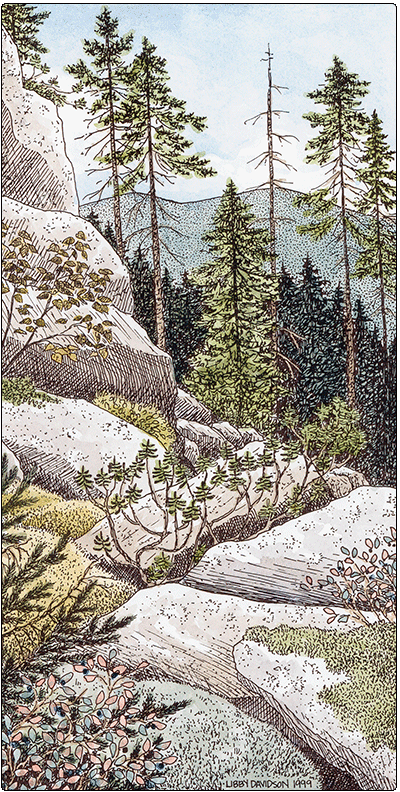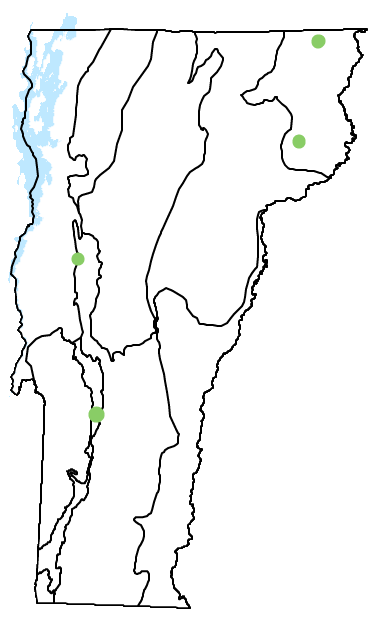Ecology and Physical Setting
The dramatic views from a Cold Air Talus Woodland may make the arduous and even dangerous trek there worthwhile. These woodlands are often perched above surrounding forest and landscape. Large areas of Open Talus extend above the woodland for hundreds of feet.
Cold Air Talus Woodland is found where steep slopes or deep valleys allow cold air to drain and settle, and where talus blocks have collected over millennia. On large areas of open talus, heating of the rocks on a sunny day causes local temperatures to rise significantly, just as sun on a parking lot makes it intensely hot. The hot air is less dense than the cooler surrounding air and so rises above it. This creates a dramatic temperature stratification, with cool air settling to the base of the steep slope. Deep spaces between the rocks enhance this effect by providing a place for the cool air to stay and be protected from stirring winds. “Ice caves” are the result. Some of these caves have ice until June or early July.
The cold temperature of the rocks relative to warm summer air causes moisture to condense, just as droplets of water appear on a cold beverage pulled from the refrigerator. The result is a cool, moist habitat that supports plants such as sphagnum moss, Labrador tea, and black spruce, which are normally found in bogs or high in the mountains. In neighboring states, similar communities support several rare arctic-alpine plants—perhaps further investigation of Vermont’s examples will yield such treasures.
As is true of other talus woodlands, soil accumulates in spaces between the rocks, or in small crevices on the rocks themselves, but many areas are devoid of soil. Trees are low and slow growing, and shrubs and herbs are sparse.
Vegetation
Cold Air Talus Woodlands have open canopies of scattered trees, including black spruce, red spruce, and birches, with low shrubs of the heath family, a group of plants that is especially well adapted to moist, infertile soils. Labrador tea and leatherleaf are two heath shrubs characteristic of this community, but not found in other talus settings. Where there is a bit of soil, Appalachian polypody and a few other vascular plants may be present. Mosses and lichens are abundant.
Wildlife Habitat
 These cold, damp, and mossy talus woodlands support several small mammals that make use of the crevices in the rock and the space between rocks for cover and nest-building. Long-tailed shrew and rock vole are rare species associated with Cold Air Talus Woodlands. Smoky shrew and southern red-backed vole are more common species that also occur in these talus woodlands.
These cold, damp, and mossy talus woodlands support several small mammals that make use of the crevices in the rock and the space between rocks for cover and nest-building. Long-tailed shrew and rock vole are rare species associated with Cold Air Talus Woodlands. Smoky shrew and southern red-backed vole are more common species that also occur in these talus woodlands.
Related Communities
- Open Talus is often associated with this community and is adjacent to it upslope. This community is sparsely vegetated and lacks the most northern elements, such as black spruce and Labrador tea.
- Boreal Talus Woodland is often adjacent to Cold Air Talus Woodland and is related to it, but lacks the most northern elements.
Conservation Status and Management Considerations
All examples of this very rare community should be protected, and should be well-buffered from any activities, including timber harvesting
in adjacent forests, that could alter the local microclimate.
Distribution/Abundance
This is a rare community in Vermont. Small examples are known from the Southern Green Mountains and Northeastern Highlands. More extensive examples are documented in New Hampshire’s White Mountains. The community likely occurs in New York, Maine, and southeastern Canada as well.
Characteristic Plants
Trees
Abundant Species
Black spruce – Picea mariana
Red spruce – Picea rubens
Heart-leaved paper birch – Betula cordifolia
Paper birch – Betula papyrifera
Occasional to Locally Abundant Species
Balsam fir – Abies balsamea
American mountain ash – Sorbus americana
Shrubs
Occasional to Locally Abundant Species
Labrador tea – Rhododendron groenlandicum
Low sweet blueberry – Vaccinium angustifolium
Velvetleaf blueberry – Vaccinium myrtilloides
Leatherleaf – Chamaedaphne calyculata
Herbs
Occasional to Locally Abundant Species
Appalachian polypody – Polypodium appalachianum
Creeping snowberry – Gaultheria hispidula
Bryophytes and Lichens
Abundant Species
Moss – Sphagnum capillifolium
Schreber’s moss – Pleurozium schreberi
Windswept moss – Dicranum polysetum
Moss – Polytrichum strictum
Occasional to Locally Abundant Species
Pincushion moss – Leucobryum glaucum
Windswept moss – Dicranum ontariense
Windswept moss – Dicranum flagellare
Liverwort – Ptilidium pulcherrimum
Lichen – Umbilicaria mammulata
Lichen – Cladonia uncialis
Reindeer Lichen – Cladonia/Cladina spp
Associated Animals
Smoky shrew – Sorex fumeus
Southern red-backed vole – Myodes gapperi
Rare and Uncommon Animals
Long-tailed shrew – Sorex dispar
Rock vole – Microtus chrotorrhinus
Places to Visit
Umpire Mountain, Victory, Victory State Forest, Vermont Department of Forests, Parks, and Recreation
Bristol Cliffs, Bristol, Green Mountain National Forest
